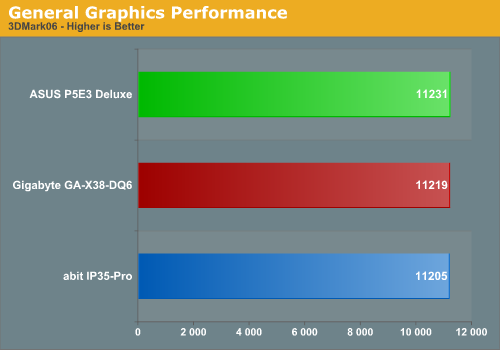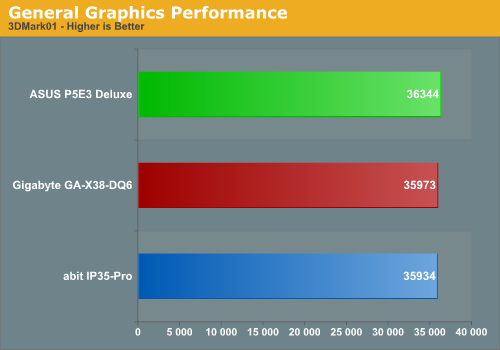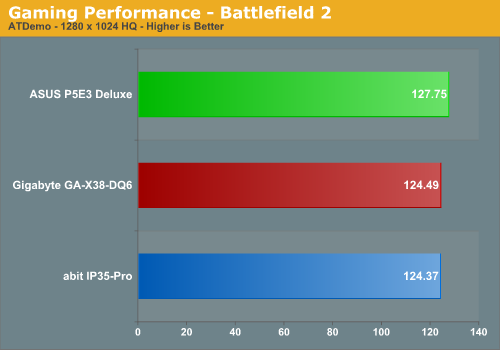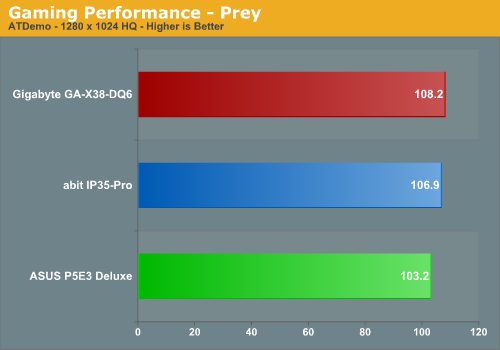ASUS P5E3 Deluxe: X38 and DDR3 arrives... almost
by Gary Key on September 18, 2007 4:00 AM EST- Posted in
- Motherboards
Gaming and Graphics Performance
The 3DMark series of benchmarks developed and provided by Futuremark are among the most widely used tools for benchmark reporting and comparisons. Although the benchmarks are very useful for providing apples-to-apples comparisons across a broad array of GPU and CPU configurations, they are not a substitute for actual application and gaming benchmarks. In this sense we consider the 3DMark benchmarks to be purely synthetic in nature but still valuable for providing consistent measurements of performance.


In our 3DMark06 test, all of the boards are basically even in this test. When looking at the individual tests, the ASUS board scores slightly better in the SM2.0 and SM3.0 tests while the CPU scores are just about identical between all three boards - we'll ignore the ASUS board's seven point advantage.
In the more memory and CPU throughput sensitive 3DMark01 benchmark we see our ASUS P5E3 Deluxe board is around 1% faster. We believe Gigabyte still has some tuning left to complete with their DDR2 X38 board as it scored a fairly anemic 35311 with the memory set to DDR2-800 with 3-4-3-9 1T timings. The differences in performance are not really noticeable in either 3DMark unless you're looking to reach the top of the ORB, which we have a good feeling the X38 was designed to do with the right setup.
Gaming Performance
As usual, gaming performance was tested with a couple popular games. We ran our benchmarks at a 1280x1024 resolution with high quality settings
Battlefield 2
This benchmark is performed using DICE's built-in demo playback functionality with additional capture capabilities designed in house. During the benchmark, the camera switches between players and vehicles in order to capture the most action possible. There is a significant amount of smoke, explosions, and vehicle usage as this a very GPU intensive Battlefield 2 benchmark. We run Battlefield 2 using medium quality graphics settings available in the video settings. The game itself is best experienced with average in-game frame rates of 35 and up.

Prey
Prey offers some superb action sequences, unique weapons and characters, and is a visually stunning game at times. It still requires a very good GPU to run it with all of the eye candy turned on. We set all graphic settings to their maximum except for AA/AF and utilize a custom timedemo that takes place during one of the more action oriented sequences. We generally find the game to be enjoyable with an average frame rate above 35fps.

Gaming Summary
The ASUS P5E3 provides an almost 3% improvement in frame rates under BF2, which tends to be more CPU limited than most games, but in the latency sensitive Prey benchmark we find it falls about 5% behind the Gigabyte board. This is the only benchmark where we witnessed a measurable decrease in performance when utilizing DDR3 at 1066 on the X38 chipset. For now, we will chalk it up to the BIOS needing fine tuning as other latency sensitive benchmarks did not show this pattern in offline testing. Once we receive the shipping BIOS for the retail boards, we will revisit these same games and provide CrossFire results against the P35 and 975X equipped boards. However, the preliminary CrossFire results show minimal gains for the X38 over the 975X when comparing percentage increases between single and dual card configurations.
The 3DMark series of benchmarks developed and provided by Futuremark are among the most widely used tools for benchmark reporting and comparisons. Although the benchmarks are very useful for providing apples-to-apples comparisons across a broad array of GPU and CPU configurations, they are not a substitute for actual application and gaming benchmarks. In this sense we consider the 3DMark benchmarks to be purely synthetic in nature but still valuable for providing consistent measurements of performance.


In our 3DMark06 test, all of the boards are basically even in this test. When looking at the individual tests, the ASUS board scores slightly better in the SM2.0 and SM3.0 tests while the CPU scores are just about identical between all three boards - we'll ignore the ASUS board's seven point advantage.
In the more memory and CPU throughput sensitive 3DMark01 benchmark we see our ASUS P5E3 Deluxe board is around 1% faster. We believe Gigabyte still has some tuning left to complete with their DDR2 X38 board as it scored a fairly anemic 35311 with the memory set to DDR2-800 with 3-4-3-9 1T timings. The differences in performance are not really noticeable in either 3DMark unless you're looking to reach the top of the ORB, which we have a good feeling the X38 was designed to do with the right setup.
Gaming Performance
As usual, gaming performance was tested with a couple popular games. We ran our benchmarks at a 1280x1024 resolution with high quality settings
Battlefield 2
This benchmark is performed using DICE's built-in demo playback functionality with additional capture capabilities designed in house. During the benchmark, the camera switches between players and vehicles in order to capture the most action possible. There is a significant amount of smoke, explosions, and vehicle usage as this a very GPU intensive Battlefield 2 benchmark. We run Battlefield 2 using medium quality graphics settings available in the video settings. The game itself is best experienced with average in-game frame rates of 35 and up.

Prey
Prey offers some superb action sequences, unique weapons and characters, and is a visually stunning game at times. It still requires a very good GPU to run it with all of the eye candy turned on. We set all graphic settings to their maximum except for AA/AF and utilize a custom timedemo that takes place during one of the more action oriented sequences. We generally find the game to be enjoyable with an average frame rate above 35fps.

Gaming Summary
The ASUS P5E3 provides an almost 3% improvement in frame rates under BF2, which tends to be more CPU limited than most games, but in the latency sensitive Prey benchmark we find it falls about 5% behind the Gigabyte board. This is the only benchmark where we witnessed a measurable decrease in performance when utilizing DDR3 at 1066 on the X38 chipset. For now, we will chalk it up to the BIOS needing fine tuning as other latency sensitive benchmarks did not show this pattern in offline testing. Once we receive the shipping BIOS for the retail boards, we will revisit these same games and provide CrossFire results against the P35 and 975X equipped boards. However, the preliminary CrossFire results show minimal gains for the X38 over the 975X when comparing percentage increases between single and dual card configurations.










60 Comments
View All Comments
DigitalFreak - Tuesday, September 18, 2007 - link
Funny thing is, there were quite a few boards a year or two ago that had Firewire 800 (mainly from Gigabyte). Not sure why everyone is going back to Firewire 400.Gary Key - Tuesday, September 18, 2007 - link
Gigabyte use to have Firewire 800 and from all indications about a dozen (me included) people cared about it according to their marketing group, plus the cost was about double for the chipset. After speaking, sometimes pleading, the motherboard manufacturers are going to stick with Firewire 400 for the time being, originally most of the new boards were not going to have it.Hulk - Tuesday, September 18, 2007 - link
It's great to compare this new chipset to other current designs but a lot of people, like myself, are considering an upgrade from older designs. I have a P5B Deluxe and would like to see a 965 based chipset in the performance graphsgramboh - Tuesday, September 18, 2007 - link
I'm also a P5B Deluxe owner and I don't see much benefit to moving to P35/X38 at all. There might be a 3-5% performance boost and potentially better overclocking, but really nothing is different.I plan to wait for the next generation MB's and for DDR3 prices to drop. I might then upgrade my mainboard/memory in late 2008/early 2009.
FWIW I plan to drop in a 45nm Penryn quad core into my P5B-Deluxe in summer 2008.
Gary Key - Tuesday, September 18, 2007 - link
We will have comparisons to the older boards in the launch article, well, the article that will contain retail boards. Right now, our first retail board with the revised X38 will not arrive until this Friday. Monday might be just be a fluff PR article on the chipset specifics until we get at another board or two in.hifisoftware - Tuesday, September 18, 2007 - link
Good review.It's good to see DDR3 reviews once in a full moon (just to know where it stands performance wise), but 99% of people would rather see DDR2 review. DDR3 is just way, way more expensive without providing anything in return. I am looking for a new system so I want to know whether I should go with P35 or X38? Sounds like X38 will be more expensive and not much better (I do not care about running cooler, unless it can be translated to a higher overclock)
JarredWalton - Tuesday, September 18, 2007 - link
The quad-core FSB OC results are quite a bit higher than anything we've seen so far. Many quad cores have issues running at FSBs beyond the low 400MHz range. Then again, with the lowest quad-core having a 9X multiplier, I don't really see this as a huge limitation.hifisoftware - Tuesday, September 18, 2007 - link
Thanks. I guess then there is a reason for me to wait 2-3 weeks to decide if X38 price justifies it's OC abilities.n0nsense - Tuesday, September 18, 2007 - link
In your case will be smarter to wait for chipsets with PCIe 2 support.not to mention soon coming HybridSLI with 1600MHz support from Nvidia and X48 from intel.
and the Phenoms triple and quad cores will be released. Many new technologies. If it's not broken, let it work another half year.
n0nsense - Tuesday, September 18, 2007 - link
The passive cooling solution is good, but have some problem.The problem starting when you install this heatpipe cooled boards into cases like Enermax CS-718 (http://rusisrael.com/albums/pic/o/00/00/28/2863.jp...">http://rusisrael.com/albums/pic/o/00/00/28/2863.jp.... According to Asus support, "After all, the board is not designed to be installed "upside-down"" and they suggest to consider other cooling solutions in case of overclocking. It took me more then a week to get straight answer for the question "Does installation direction have negative affect on cooling". The question was asked about my P5N32-E SLI, but i suspect it remains true for all boards with heatpipe cooling solution. What is disappointing me most, is the fact that this information not found on Asus's site as "case compatibility" or "installation directions" or some other kind of note or warning.